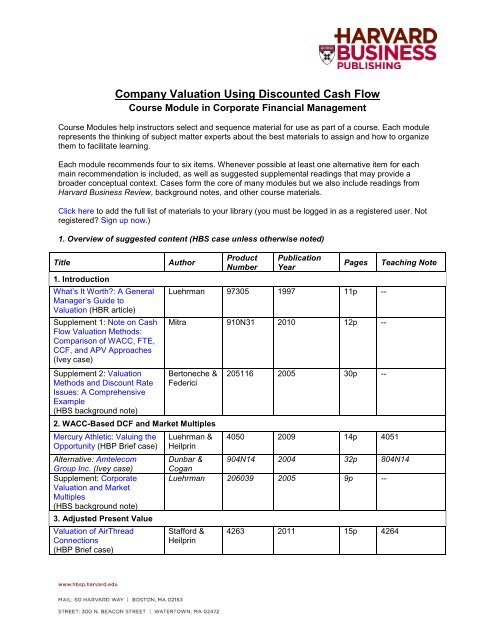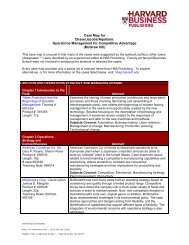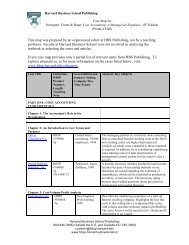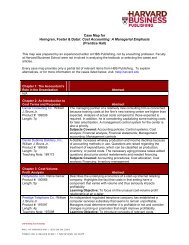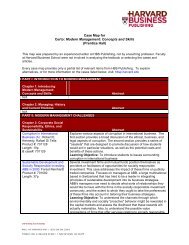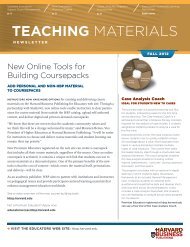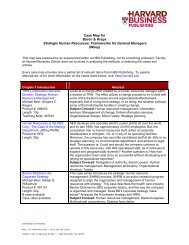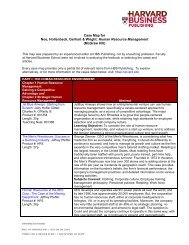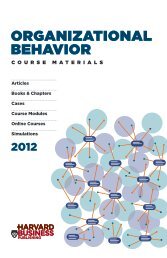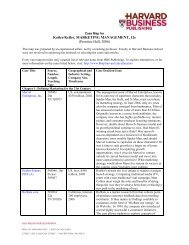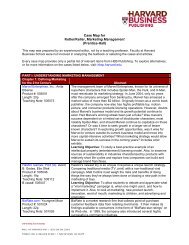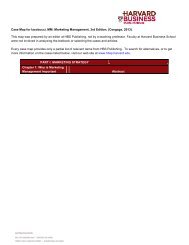Company Valuation Using Discounted Cash Flow
Company Valuation Using Discounted Cash Flow
Company Valuation Using Discounted Cash Flow
You also want an ePaper? Increase the reach of your titles
YUMPU automatically turns print PDFs into web optimized ePapers that Google loves.
<strong>Company</strong> <strong>Valuation</strong> <strong>Using</strong> <strong>Discounted</strong> <strong>Cash</strong> <strong>Flow</strong><br />
Course Module in Corporate Financial Management<br />
Course Modules help instructors select and sequence material for use as part of a course. Each module<br />
represents the thinking of subject matter experts about the best materials to assign and how to organize<br />
them to facilitate learning.<br />
Each module recommends four to six items. Whenever possible at least one alternative item for each<br />
main recommendation is included, as well as suggested supplemental readings that may provide a<br />
broader conceptual context. Cases form the core of many modules but we also include readings from<br />
Harvard Business Review, background notes, and other course materials.<br />
Click here to add the full list of materials to your library (you must be logged in as a registered user. Not<br />
registered? Sign up now.)<br />
1. Overview of suggested content (HBS case unless otherwise noted)<br />
Title Author<br />
1. Introduction<br />
What’s It Worth?: A General<br />
Manager’s Guide to<br />
<strong>Valuation</strong> (HBR article)<br />
Supplement 1: Note on <strong>Cash</strong><br />
<strong>Flow</strong> <strong>Valuation</strong> Methods:<br />
Comparison of WACC, FTE,<br />
CCF, and APV Approaches<br />
(Ivey case)<br />
Supplement 2: <strong>Valuation</strong><br />
Methods and Discount Rate<br />
Issues: A Comprehensive<br />
Example<br />
(HBS background note)<br />
Product<br />
Number<br />
Publication<br />
Year<br />
Luehrman 97305 1997 11p --<br />
Mitra 910N31 2010 12p --<br />
Bertoneche &<br />
Federici<br />
2. WACC-Based DCF and Market Multiples<br />
Mercury Athletic: Valuing the<br />
Opportunity (HBP Brief case)<br />
Alternative: Amtelecom<br />
Group Inc. (Ivey case)<br />
Supplement: Corporate<br />
<strong>Valuation</strong> and Market<br />
Multiples<br />
(HBS background note)<br />
3. Adjusted Present Value<br />
<strong>Valuation</strong> of AirThread<br />
Connections<br />
(HBP Brief case)<br />
205116 2005 30p --<br />
Pages Teaching Note<br />
Luehrman &<br />
Heilprin<br />
4050 2009 14p 4051<br />
Dunbar &<br />
Cogan<br />
904N14 2004 32p 804N14<br />
Luehrman 206039 2005 9p --<br />
Stafford &<br />
Heilprin<br />
4263 2011 15p 4264
Alternative: Seagate<br />
Technology Buyout<br />
Supplement: <strong>Using</strong> APV: A<br />
Better Tool for Valuing<br />
Operations (HBR article)<br />
4. Capital <strong>Cash</strong> <strong>Flow</strong><br />
Berkshire Partners: Bidding<br />
for Carter’s<br />
Supplement: Note on Capital<br />
<strong>Cash</strong> <strong>Flow</strong> <strong>Valuation</strong><br />
(HBS background note)<br />
5. Equity <strong>Cash</strong> <strong>Flow</strong><br />
Andrade 201094 2001 19p 204160<br />
Luehrman 97306 1997 8p --<br />
Baker &<br />
Quinn<br />
205058 2005 14p 207029<br />
Ruback 295069 1994 13p --<br />
Acova Radiateurs Meulbroek 295150 1995 12p 200003<br />
Alternative: The Hertz<br />
Corporation (A)<br />
Supplement: Note on Valuing<br />
Equity <strong>Cash</strong> <strong>Flow</strong>s<br />
Luehrman &<br />
Scott<br />
208030 2007 18p 209068<br />
Luehrman 295085 1994 10p 295149<br />
II. Rationale for selecting and sequencing the items in this module<br />
Section 1 begins with the bestselling Harvard Business Review article “What’s It Worth? A General<br />
Manager’s Guide to <strong>Valuation</strong>”. The article first describes the limitations of the standard WACC (Weighted<br />
Average Cost of Capital) version of the DCF (<strong>Discounted</strong> <strong>Cash</strong> <strong>Flow</strong>) valuation of companies. As an<br />
alternative, the article then recommends the Adjusted Present Value, Real Options, and Equity <strong>Cash</strong><br />
<strong>Flow</strong> methods as better suited for valuing operations, opportunities, and ownership claims, respectively.<br />
The first supplement, “Note on <strong>Cash</strong> <strong>Flow</strong> <strong>Valuation</strong> Methods: Comparison of WACC, FTE, CCF and APV<br />
Approaches” (from Ivey), covers the same material at more length, and uses a capstone example to<br />
compare and contrast the various methods. The second supplement, the HBS note <strong>Valuation</strong> Methods<br />
and Discount Rate Issues: A Comprehensive Example reviews the various valuation methods and uses a<br />
simple example to demonstrate the consistency of their results under similar assumptions.<br />
Each of the subsequent sections highlights a particular valuation method, usually comparing it with one or<br />
more other methods. Section 2 compares the DCF valuation using WACC and the market multiples<br />
approaches. The HBP Briefcase, Mercury Athletic: Valuing the Opportunity, uses the potential acquisition<br />
of a footwear subsidiary to teach students DCF valuation using WACC, and compares the results with<br />
those drawn from market multiples approaches.The alternative is the Amtelecom Group Inc., a singlesession<br />
Ivey case, which explores the valuation of a Canadian telecommunications subsidiary either for<br />
sale to a buyer or for an initial public offering. In addition to valuing the subsidiary by DCF and market<br />
multiple methods, students are also asked to do a sum of parts valuation of the diversified firm. The<br />
supplementary technical note Corporate <strong>Valuation</strong> and Market Multiples reviews the implementation and<br />
limits of the market multiples method.<br />
Section 3 introduces Adjusted Present Value (APV). In the main selection, the HBP Briefcase <strong>Valuation</strong><br />
of AirThread Connections, students are required to value a potential acquisition, a regional cellular<br />
provider, with the WACC-based DCF method and with APV. They must choose which method to use<br />
when the capital structure is stable and when it is changing, and estimate the effect of capital structure<br />
changes on assumptions in determining beta and the cost of capital. The alternative, Seagate Technology<br />
Buyout, is a two-session case that concerns a leveraged buyout (LBO) of the disk drive operations of
Seagate. Students are asked to perform both WACC-based DCF and APV valuations of the target<br />
(including estimating the cost of capital from comparables) as well as address the impact of financing<br />
decisions of on value. The supplementary HBR article, “<strong>Using</strong> APV: A Better Tool for Valuing Operations,”<br />
describes an APV analysis using a hypothetical company.<br />
Section 4 is concerned with the capital cash flow method. In Berkshire Partners: Bidding for Carter’s,<br />
Berkshire Partners is making a bid and deciding on a financial structure for an LBO of a leading producer<br />
of children’s apparel. Berkshire’s financial team uses capital cash flow to calculate the value of William<br />
Carter Co.The students are also asked to consider how value is created in the private equity world. Note<br />
on Capital <strong>Cash</strong> <strong>Flow</strong> <strong>Valuation</strong>, the supplement, walks students through the mechanics of the<br />
calculation.<br />
Section 5, on the equity cash flow (ECF) method, closes the module with Acova Radiateurs, a takeover<br />
candidate that students must value for an LBO in an international setting. The teaching note provides<br />
one- and two-day teaching plans and ECF and CCF valuations of Acova. The alternative, The Hertz<br />
Corporation (A), is a more difficult case, examining the LBO of Hertz in 2005. Students are asked to<br />
locate the sources of value in the deal, in operations, and in the financing and deal structures. While the<br />
case itself lacks detailed financial projections, both the teaching note and an electronic spreadsheet<br />
include sample projections. The supplement, Note on Valuing Equity <strong>Cash</strong> <strong>Flow</strong>s, is for advanced<br />
students and teaches the mechanics and examines the biases and shortcomings of the method.<br />
As capstones, you might want to consider two HBP online simulations, Finance Simulation:<br />
Blackstone/Celanese and Finance Simulation: M&A in Wine Country. The former is based on the<br />
landmark acquisition of Celanese AG by the Blackstone Group in 2003, and asks students within the<br />
greater context of the case to use equity and capital cash flow methods to give a valuation to Celanese<br />
AG. In the second online simulation, students play the role of the CEO at one of three-publicly traded<br />
wine producers, evaluating merger and/or acquisition opportunities among the three companies. WACCbased<br />
DCF, APV, and Market Multiples are some of the methods at their disposal to work up bids and<br />
negotiate deals.


